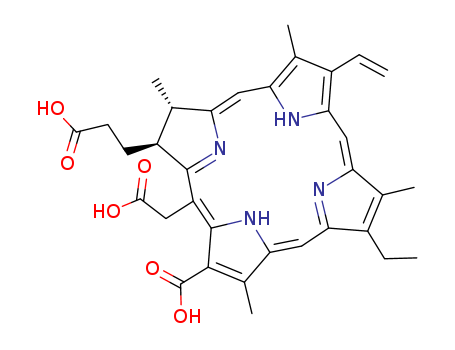- Chemical Name:18-(2-Carboxyethyl)-20-(carboxymethyl)-12-ethenyl-7-ethyl-3,8,13,17-tetramethyl-17,18,22,23-tetrahydroporphyrin-2-carboxylic acid
- CAS No.:19660-77-6
- Molecular Formula:C34H36N4O6
- Molecular Weight:596.683
- Hs Code.:2933998090
- European Community (EC) Number:243-209-4
- ChEMBL ID:CHEMBL4166417
- Nikkaji Number:J195.874G
- Wikidata:Q110185473
- Mol file:19660-77-6.mol
Synonyms:13-carboxy-17-(2-carboxyethyl)-15-carboxymethyl-17,18-trans-dihydro-3-vinyl-8-ethyl-2,7,12,18-tetramethylporphyrin;2-porphinepropionic acid, 18-carboxy-20-(carboxymethyl)-13-ethyl-2beta,3-dihydro-3beta,7,12,17-tetramethyl-8-vinyl-;21H,23H-porphine-2-propanoic acid, 18-carboxy-20-(carboxymethyl)-8-ethenyl-13-ethyl-2,3-dihydro-3,7,12,17-tetramethyl-, (2S-trans);21h,23h-porphine-7-propanoic acid, 3-carboxy-5-(carboxymethyl)-13-ethenyl-18-ethyl-7,8-dihydro-2,8,12,17-tetramethyl-, (7S,8S)-;BLC 1010;BLC-1010;BLC1010;chlorin A6;chlorin e6;chlorine A6;chlorine e6;fotolon;photochlorine;Photolon;phytochlorin




